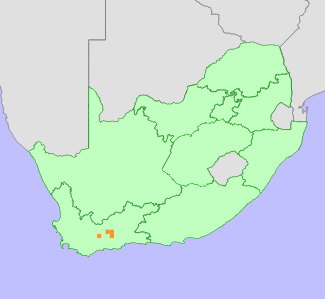|
Scientific Name | Syringodea saxatilis M.P.de Vos |
Higher Classification | Monocotyledons |
Family | IRIDACEAE |
National Status |
Status and Criteria | Vulnerable B1ab(ii,iii)+2ab(ii,iii) |
Assessment Date | 2022/10/03 |
Assessor(s) | N. Lombard, J.H. Vlok, R.C. Turner & D. Raimondo |
Justification | A western Little Karoo endemic with an extent of occurrence (EOO) of 102 km² and an area of occupancy (AOO) of 24-50 km². It is known from six locations, three of which are not threatened and not likely to become threatened in the near future. However, the three locations around Ladismith are experiencing habitat loss due to crop cultivation, and urban and industrial development. Although this species is currently only known from six locations it is likely that several more exist as this is a small, cryptic, autumn-flowering species. Based on known locations the species is assessed as Vulnerable under Criterion B. |
Distribution |
Endemism | South African endemic |
Provincial distribution | Western Cape |
Range | This species is endemic to the western Little Karoo, in the Western Cape Province of South Africa, where it occurs around Ladismith and along the southern foothills of the Anysberg. |
Habitat and Ecology |
Major system | Terrestrial |
Major habitats | Western Little Karoo, Montagu Shale Renosterveld |
Description | It grows in stony washes on low quartzite or sandstone outcrops. |
Threats |
| Urban expansion and development is a threat at the Ladismith location. There is also crop development at this location that may cause habitat loss for this species. Grazing pressure remains a threat throughout its range. |
Population |
The current population size is unknown but it is suspected to be declining due to urban expansion, crop development and grazing pressure. The number of locations are currently estimated to be between six and ten but there may be several more (Jan Vlok, pers. Comm., 2022).
|
Population trend | Decreasing |
Assessment History |
Taxon assessed |
Status and Criteria |
Citation/Red List version | | Syringodea saxatilis M.P.de Vos | VU B1ab(ii,iii,iv,v) | Raimondo et al. (2009) | | Syringodea saxatilis M.P.de Vos | Insufficiently Known | Hilton-Taylor (1996) | | Syringodea saxatilis M.P.de Vos | Uncertain | Hall et al. (1980) | |
Bibliography |
Goldblatt, P. and Manning, J.C. 2000. Cape Plants: A conspectus of the Cape Flora of South Africa. Strelitzia 9. National Botanical Institute, Cape Town.
Goldblatt, P. and Manning, J.C. 2020. Iridaceae of southern Africa. Strelitzia 42. South African National Biodiversity Institute, Pretoria.
Hall, A.V., De Winter, M., De Winter, B. and Van Oosterhout, S.A.M. 1980. Threatened plants of southern Africa. South African National Scienctific Programmes Report 45. CSIR, Pretoria.
Hilton-Taylor, C. 1996. Red data list of southern African plants. Strelitzia 4. South African National Botanical Institute, Pretoria.
Raimondo, D., von Staden, L., Foden, W., Victor, J.E., Helme, N.A., Turner, R.C., Kamundi, D.A. and Manyama, P.A. 2009. Red List of South African Plants. Strelitzia 25. South African National Biodiversity Institute, Pretoria.
Vlok, J. and Schutte-Vlok, A.L. 2010. Plants of the Klein Karoo. Umdaus Press, Hatfield.
|
Citation |
| Lombard, N., Vlok, J.H., Turner, R.C. & Raimondo, D. 2022. Syringodea saxatilis M.P.de Vos. National Assessment: Red List of South African Plants version 2024.1. Accessed on 2025/11/16 |
 Comment on this assessment
Comment on this assessment


